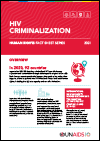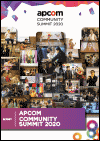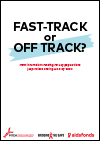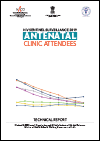Publications on Key Populations

Resource | Fact Sheets,
The 2021-2026 Global AIDS Strategy has bold and critical new targets on realizing human rights, reducing stigma, discrimination and violence and removing harmful punitive laws as a pathway to ending inequalities and ultimately ending AIDS. To aid in the scale up of interventions to remove these societal barriers, UNAIDS has produced a series of fact sheets on human rights in various areas, highlighting the critical need to scale up action on rights. They are a series of short, easy to digest and accessible documents outlining the latest epidemiology, the evidence of the impact of human rights interventions, the latest targets, and international guidelines, recommendations and human rights obligations relating to each topic. Fact sheets released in June 2021: HIV criminalization, HIV and people who use drugs, HIV and gay men and who have sex with other men, HIV and transgender and other gender-diverse people, HIV and sex work, HIV and people in prisons and other closed settings and HIV and stigma and discrimination.

Resource | Publications,
Amidst the COVID-19 pandemic, the APCOM Community Summit 2020 brought together delegates, speakers, community members and participants from across the Asia-Pacific Region for the first-ever hybrid conference, convened using a combination of face-to-face and virtual conferencing. The impact of COVID-19 on people living with HIV and key populations, has been felt across the region, revealing glaring inequalities and amplifying the need for better co-ordination among the community. However, despite the challenges of the past year, the community response to the pandemic has been inspirational, demonstrating the vital role of community-based organizations as lifelines for people living with HIV and key populations, as well as the wider community.

Resource | Publications,
To mark Zero Discrimination Day, APCOM launches a short report that compiles stories and articles published in the Covid-19 Effect Series, a newsletter created by APCOM to profiles issues, challenges and solutions from the LGBTQI communities and key populations across Asia and the Pacific. Since April 2020, with more than 19 issues, the series has provided a platform to leverage the voices of people living with HIV and LGBTQI to share stories, highlight challenges, showcase innovation and build strength within these communities.

Resource | Publications,
The report provides an overview of the organisation’s activities and achievements over 2019, the organisation’s twelfth year of working to improve and protect the health and rights of gay men, other men who have sex with men and people of diverse sexual orientation, gender identify and expression and sexual characteristics (SOGIESC) across Asia and the Pacific.

Resource | Publications,
This report highlights the resource gaps in HIV programming for these communities and compares this to funding for the overall HIV response. The analysis is informed by documented spending on HIV programming for key populations in low and middle-income countries (LMICs) between 2016 and 2018.

Resource | Publications,
Findings from 2019 round of HSS corroborates with previous rounds and continues to show a low and declining trend nationally, albeit a geographically diverse epidemic sub-nationally. There were 46 surveillance sites across 11 States and 45 districts, which recorded a prevalence of 1% among pregnant women. Overall, 34 districts recorded a HIV prevalence of 1% or more among pregnant women.
This technical report is opportune as the country embarks towards planning for the next phase of NACP and it is expected to support shaping the country’s response for the next five years.





